Retailing Strategies for Power Retailers with a Generator Background Considering Energy Conservation Services under the Internet of Things
Abstract
:1. Introduction
- Based on the collection, monitoring and calculation of environmental data in the electricity sales market based on IOT technology, the real-time monitoring data of energy demand of load users are used as an important basis for CHP and waste heat refrigeration supply energy for power retailers with a generator background. The new business model of cooling-heating-electricity multi-energy packages is innovatively proposed, while data analysis of costs, revenues, expansion scale of power retailers and the number of proliferations of new packages is conducted to verify the necessity of setting up energy guarantee services.
- With energy assurance services being set up by power retailers with a generator background, the proportion of coal reserves and energy losses in the cost of coal purchased by power retailers is reduced, the adverse impact of upward market fluctuations in coal prices on the costs of power retailers during the peak energy season is weakened and the expansion rate of power retailers in the market is released.
- By setting up an energy conservation service, the power retailers compress the cost of energy sales, thus reducing the cost for the load customers by making heat and cold energy a complimentary part of the electricity supply in the new package and not charging for it separately. This is conducive to safeguarding the energy rights of load customers and increasing the proliferation of the new business model on the customer side, as well as further expanding the revenue stream of the power retailers and improving its risk management capabilities.
2. Retail Strategy Model for Power Retailers Considering Energy Conservation Services
2.1. Modeling Principles
2.2. A System Dynamics Model for Power Retailers with a Generator Background
2.2.1. Power Retailers Cooling-Heat-Electricity Multi-Power Package Model
2.2.2. Power Retailers Desulphurization and Carbon Emission Model
2.2.3. Power Retailers Energy Conservation Service Model
3. Retailing Strategies for Power Retailers with a Generator Background
3.1. Cost Model for Power Retailers
3.1.1. Cost per Hour of Coal Purchased by Coal-Fired Generators
3.1.2. Operating and Maintenance Costs per Hour for Units and Energy Storage Equipment
3.1.3. Cost per Hour of Production and Discharge Carbon Emissions from Desulphurization Systems
3.1.4. Cost per Hour for Energy Assurance Services
3.2. Revenue Model for Power Retailers
3.2.1. Revenue per Hour from Participation in Peaking in Winter and Summer
3.2.2. Revenue per Hour from Sale of Electricity and Heat
3.2.3. Revenue per Hour of FGD System Operation and Production
3.3. Expansion Model for Power Retailers
3.3.1. User Appeal
3.3.2. Expansion Rate of Power Retailers
3.3.3. Size of Power Retailers
3.4. Load User Diffusion Model
3.4.1. New and Traditional Package User Expenses
3.4.2. Expansion Rate of Power Retailers
3.4.3. Number of Load User Diffusion
4. Case Analysis
4.1. Case Basic Data
4.1.1. Parameters Related to Power Retailers with a Generator Background
4.1.2. Load User Related Parameters
4.2. Analysis of Demand for Energy Assurance Services for Power Retailers
4.2.1. Analysis of Load User Diffusion Model Runs
4.2.2. Analysis of Power Retailers Cost Model Runs
4.2.3. Analysis of Power Retailers Revenue Model Runs
4.2.4. Analysis of Power Retailers Expansion Model Runs
4.3. Operation of Energy Conservation Services for Power Retailers Considering Market Fluctuations in Coal Prices
4.4. Operation of Energy Conservation Services of Power Retailers Considering Customer-Side Proliferation Stagnation
5. Conclusions
- (1)
- To respond to the construction of the retail market, power retailers with a generator background actively participate in the carbon emissions market and give full play to the advantages of CHP units. This is also based on the IOT’s technical support of data collection, interconnection and calculation for the electricity sales environment, which expands the cold-heat-electricity multi-energy package for load users and improves the efficiency of resource utilization. On the one hand, the multi-energy needs of load users are met, and on the other hand, new sources of income are opened up for the power retailers.
- (2)
- Considering the analysis of the data collection of the market environment of the power retailers, based on the operating characteristics of coal-fired generating units, FGD systems and other equipment, as well as the size of the market, a revenue and cost model regarding the power retailers with a generator background is created. The participation of the power retailers and load users in the operation is simulated to provide the demand for the energy conservation services to be set up by the power retailers.
- (3)
- Through IOT technology to monitor the cost and revenue of the power retailers in response to the risk of rising heat prices due to coal price market fluctuations in the retail market, the power retailers have set up an energy guarantee service. The proportion of energy losses and emergency reserves of the power producer is reduced, and in times of rising coal prices, the power producer’s own coal purchase costs are reduced by purchasing thermal energy from energy assurance service providers to supply customers. The comparative analysis proves that considering energy assurance services can effectively control the cost of power retailers and make profits to facilitate the expansion of power retailers. In the middle of the simulation, the scale of the power retailers increases by 13.103%.
- (4)
- In response to the risk of stagnation of customer-side diffusion in the retail market by power retailers with a generator background, the energy guarantee service was installed. Regarding the new package, proceeds from the sale of heat are forgone and heat and cold energy are sold as a bonus to electricity at an increased tariff. This significantly enhances the diffusion benefits of the new packages on the customer side. Based on real-time monitoring of data by the IOT, a comparative analysis of load customer-side diffusion and the expansion of power retailers is carried out. Considering that the retailing strategy of cooling-heating-electricity multi-energy packages for energy conservation services can effectively enhance the number of customer-side diffusion is proven: its growth trend increases from 1.0225 to 1.7408, with obvious effect, the continuous expansion of the number of users can stabilize the energy conservation security capacity of the power retailers and improve the scale expansion of the power retailers in the region.
- (5)
- Subsequently, the green generation resources that different types of generators have can be considered, and more business models can continue to be studied in depth in terms of power retailers with a generator background, providing more business models for load users.
Author Contributions
Funding
Institutional Review Board Statement
Informed Consent Statement
Data Availability Statement
Acknowledgments
Conflicts of Interest
References
- Ma, L. Building a unified national electricity market, opening a new situation in the power industry. Financ. Econ. Circ. 2022, 5, 6–7. [Google Scholar]
- The relevant comrades in charge of the National Energy Administration responded to reporters on the “14th Five-Year planning”. China Electr. Power Dly. 2022, 3, 1.
- Liu, Y.; Wang, G.; Gong, T. Research on Marketing Strategy of Power Supply Company under New Situation. Mod. Bus. Ind. 2018, 39, 69–70. [Google Scholar]
- Liang, C. Research on the Sales Marketing Strategy of Datang Huainan Luohe Power Plant. Master’s Thesis, North China Electric Power University, Beijing, China, 2017. [Google Scholar]
- Zang, N. How to build a marketing system for electricity sales companies under the reform of electric power system. China Energy 2016, 38, 44–47. [Google Scholar]
- Li, L. Analysis of Power Marketing Strategy of Power Generation Enterprises under the Background of New Electricity Reform. J. Low Carbon World 2017, 6, 232–233. [Google Scholar]
- Li, Q. The coping strategies of the selling side under the situation of power system reform. Electr. Technol. 2020, 6, 131–134. [Google Scholar]
- Fang, X.; Peng, X.; Zhang, K.; Ma, J.; Zhao, R.; Wang, J. Research progress on cold end heat supply retrofit of coal-fired cogeneration system. Huadian Technol. 2021, 43, 48–56. [Google Scholar]
- Wang, J. Research status and prospect of large-scale coal-fired cogeneration system. J. North China Electr. Power Univ. (Nat. Sci. Ed.) 2019, 46, 90–98. [Google Scholar]
- Wu, S.; Jin, X.; Liu, Z.; Che, D.; Sui, J.; Li, R.; Zhao, Y.; Wang, Z. Application of thermal recovery in regional heating/cooling system. Power Gener. Technol. 2020, 41, 578–589. [Google Scholar]
- Dai, X.; Wang, X.; An, Q.; Wang, J.; Zhuang, W.; Li, L.; Cui, D.; Sheng, T. Distributed energy trading operation mode and method based on IoT decentralized decision making. Renew. Energy 2021, 8, 1130–1136. [Google Scholar]
- Guo, M.; Chen, H.; Xiao, W.; Chen, Z.; Shen, N.; Huang, Z.; Liu, F.; Zhang, L. Optimization model of electricity sales business operation in the Internet of Things environment. Smart Power 2020, 48, 80–85+91. [Google Scholar]
- Peng, Y.; Liu, J.; Liu, J. Purchasing and selling strategies of power companies considering multi-type retail packages in a two-stage electricity market environment. Grid Technol. 2022, 46, 944–957. [Google Scholar]
- Li, Y.; Tang, J.; Zhang, S.; Xu, L.; Zhang, Z.; Yang, L. A decision model for power purchase and sale by power sales companies considering multiple uncertainties. Power Syst. Autom. 2022, 46, 33–41. [Google Scholar]
- Su, W. Risk Analysis and Response Research on Purchasing and Selling Electricity of Power Supply Enterprises in the Market Competition Environment. Master’s Thesis, North China Electric Power University, Beijing, China, 2016. [Google Scholar]
- Xu, Y.; Yang, C.; Bao, S.; Wang, H.; Wang, T. Trading decision optimization of electricity selling companies with insurance mechanism. Power Demand Side Manag. 2021, 23, 41–46. [Google Scholar]
- Zhao, S.; Wang, B.; Li, Y.; Sun, M.; Zeng, W. Analysis of distributed renewable energy incentive mechanism based on system dynamics. Power Syst. Autom. 2017, 41, 97–104+128. [Google Scholar]
- Wang, B.; Yang, X.; Yang, S. System dynamics analysis of demand response potential and effect based on long-term time dimension. J. China Electr. Eng. 2015, 35, 6368–6377. [Google Scholar]
- Li, Y. Research on the Optimization of Electricity and Coal Supply Chain System Based on Carbon Emission. Master’s Thesis, North China Electric Power University, Beijing, China, 2018. [Google Scholar]
- An, H. Calculation method of sulfur dioxide emissions from thermal power plants. North China Power Technol. 2000, 4, 11–12. [Google Scholar]
- He, Y.; Chen, Y.; Liu, Y.; Liu, H.; Liu, D.; Sun, C. Analysis of the cost of kilowatt-hour and mileage cost of energy storage. New Technol. Electr. Power 2019, 38, 1–10. [Google Scholar]
- Lv, S. Research on the Influence of Carbon Price Based on System Dynamics on Power Structure in China. Master’s Thesis, North China Electric Power University, Beijing, China, 2021. [Google Scholar]
- Cao, M.; Sun, Z.; Bai, Z.; Ju, J. Analysis of target customer groups in power market proxy trading. Power Demand Side Manag. 2021, 23, 90–96. [Google Scholar]
- Wang, R. Empirical Study on the Correlation between Futures and Spot Prices of Power Coal. Coal Econ. Res. 2021, 41, 32–40. [Google Scholar]
- Dou, X.; Zhang, P.; Li, J.; Wang, J. Analysis on the purchasing and selling strategies of power companies with different qualifications. China J. Electr. Eng. 2020, 40 (Suppl. S1), 181–187. [Google Scholar]
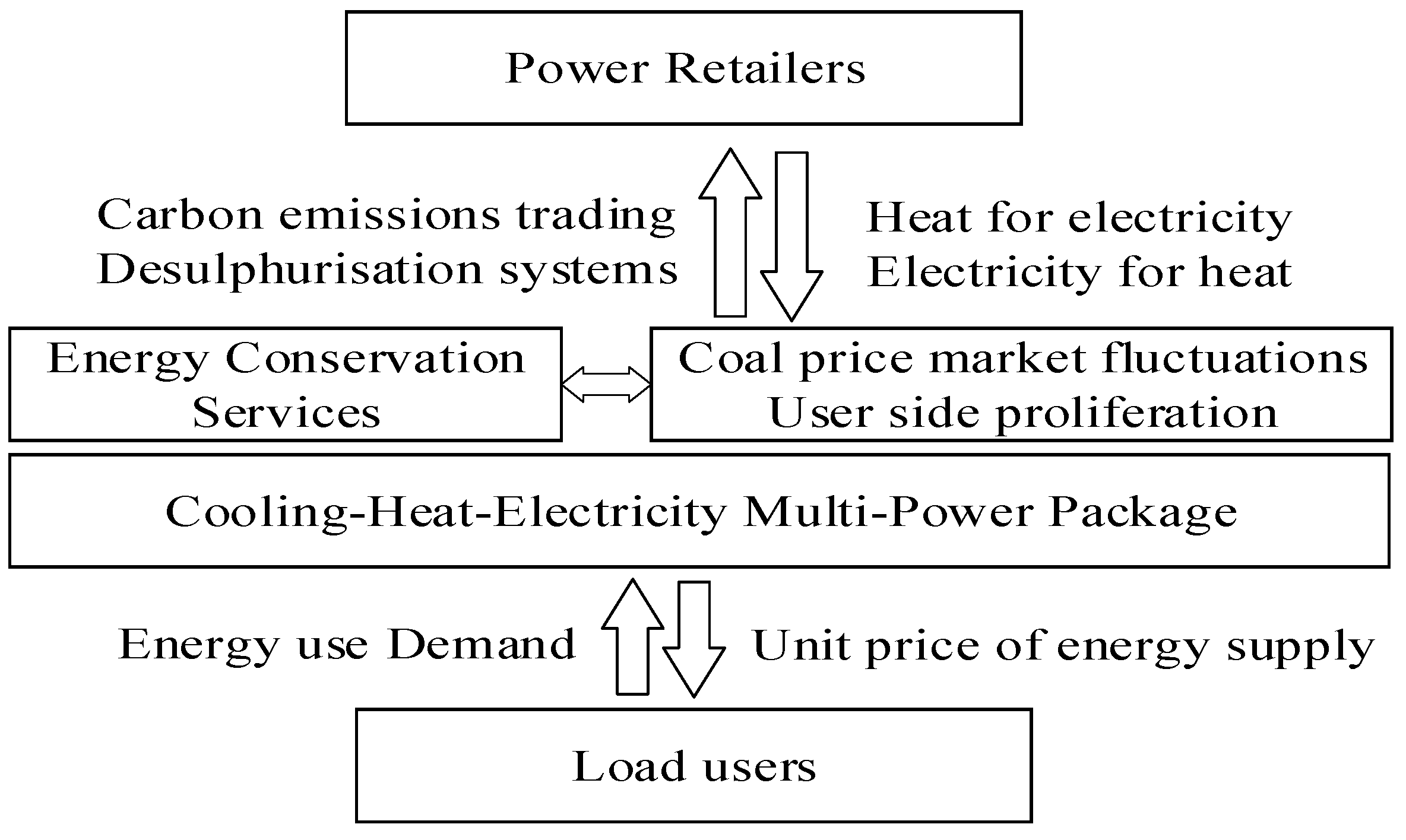



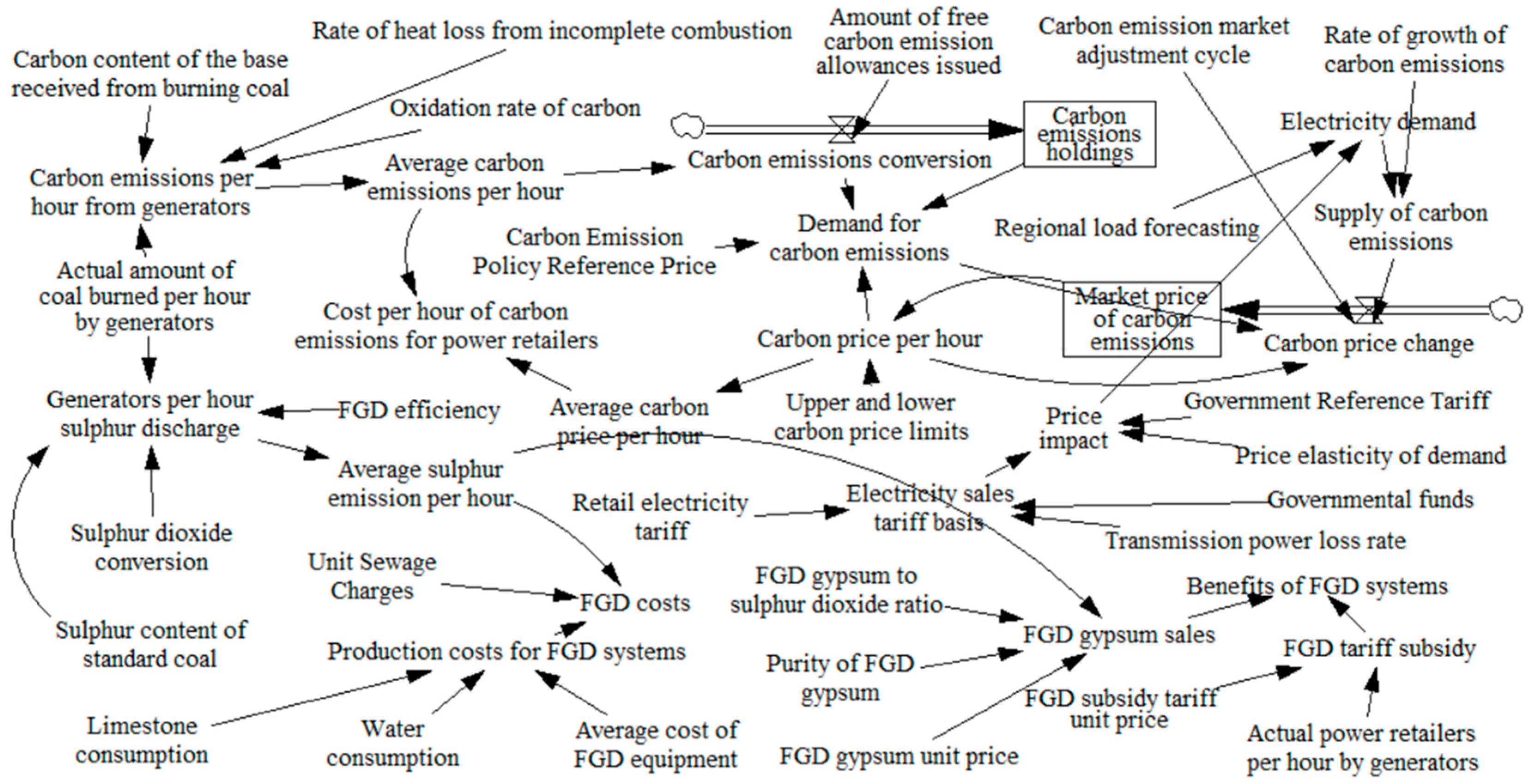



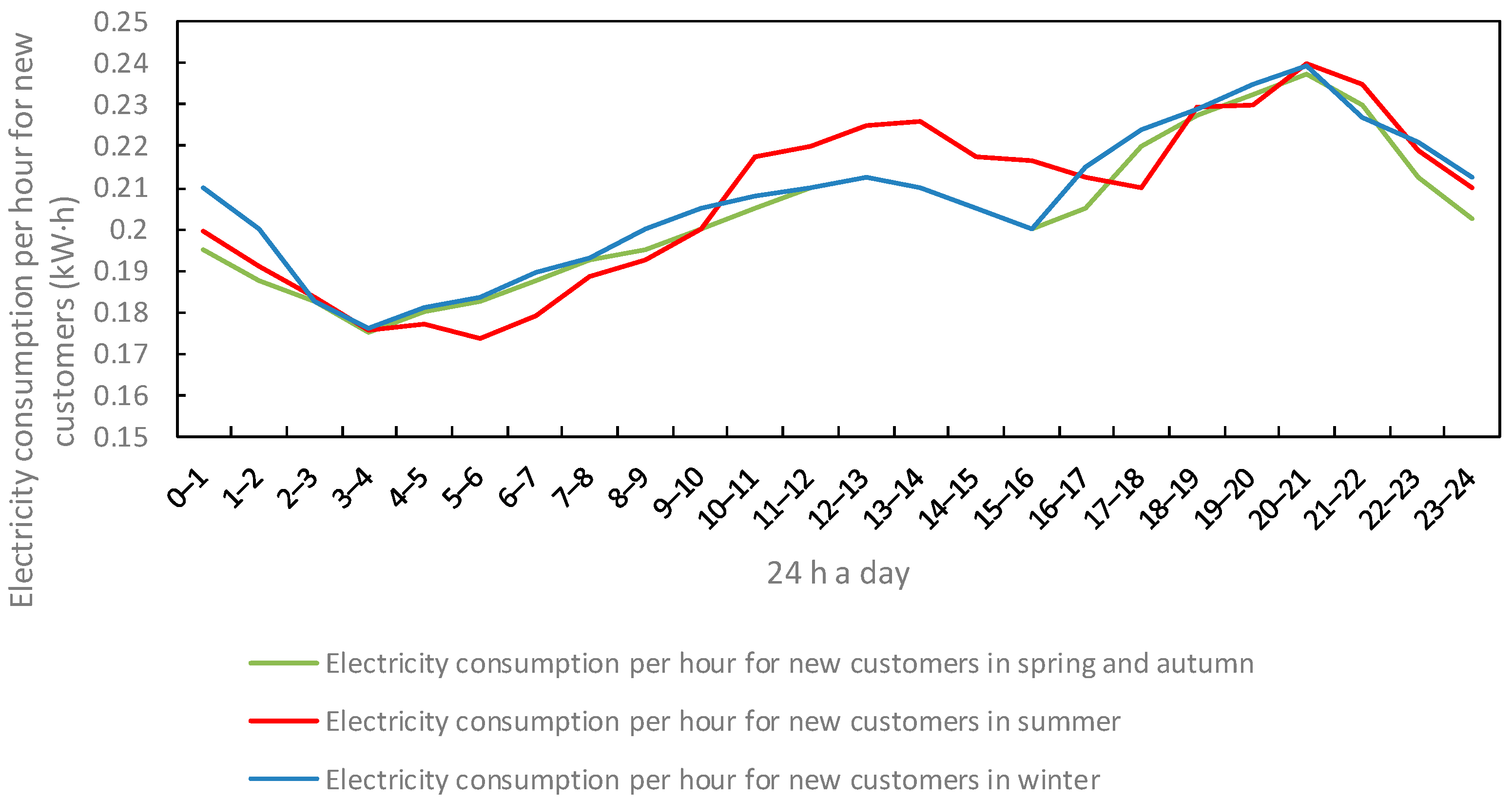
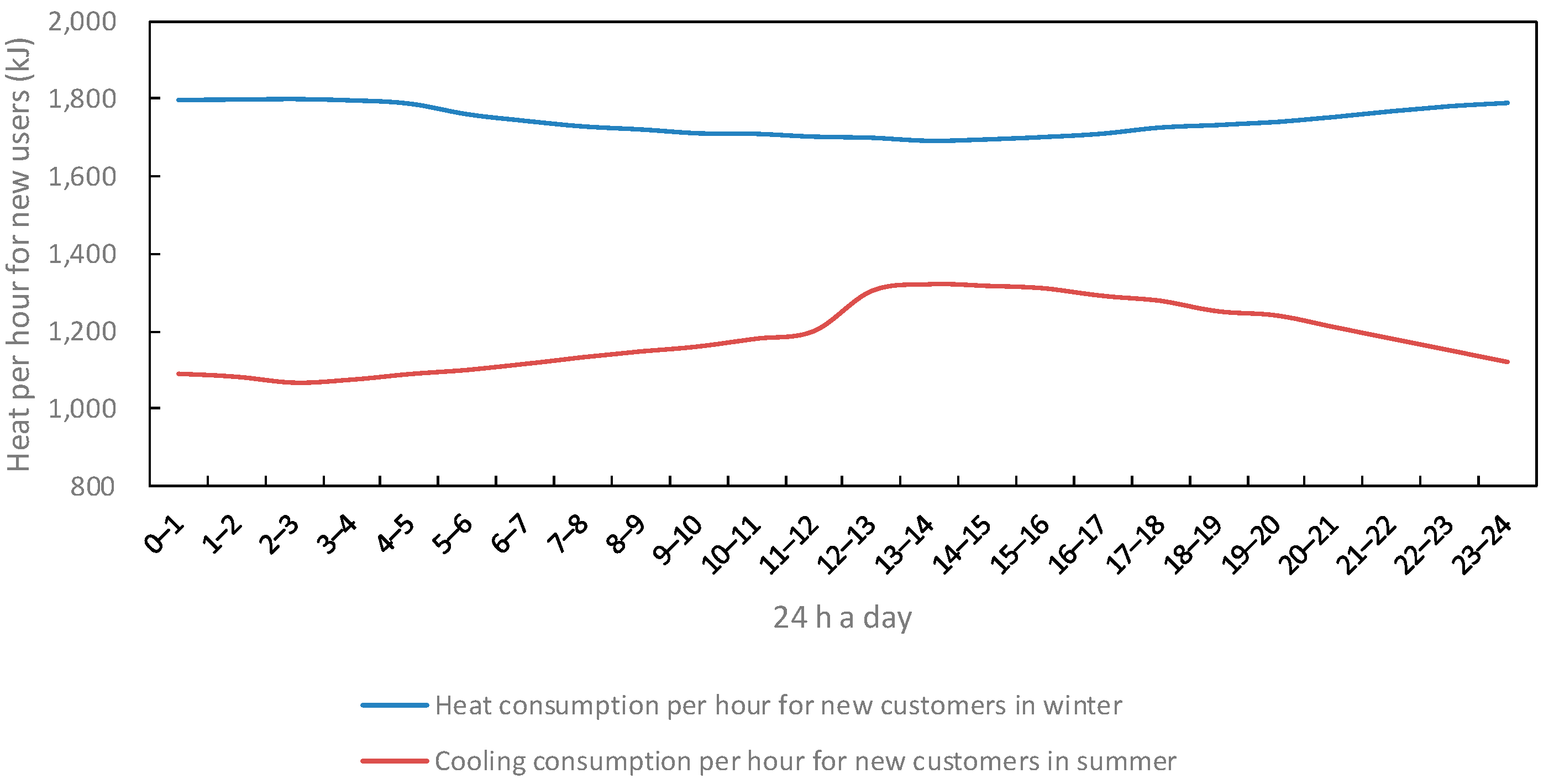





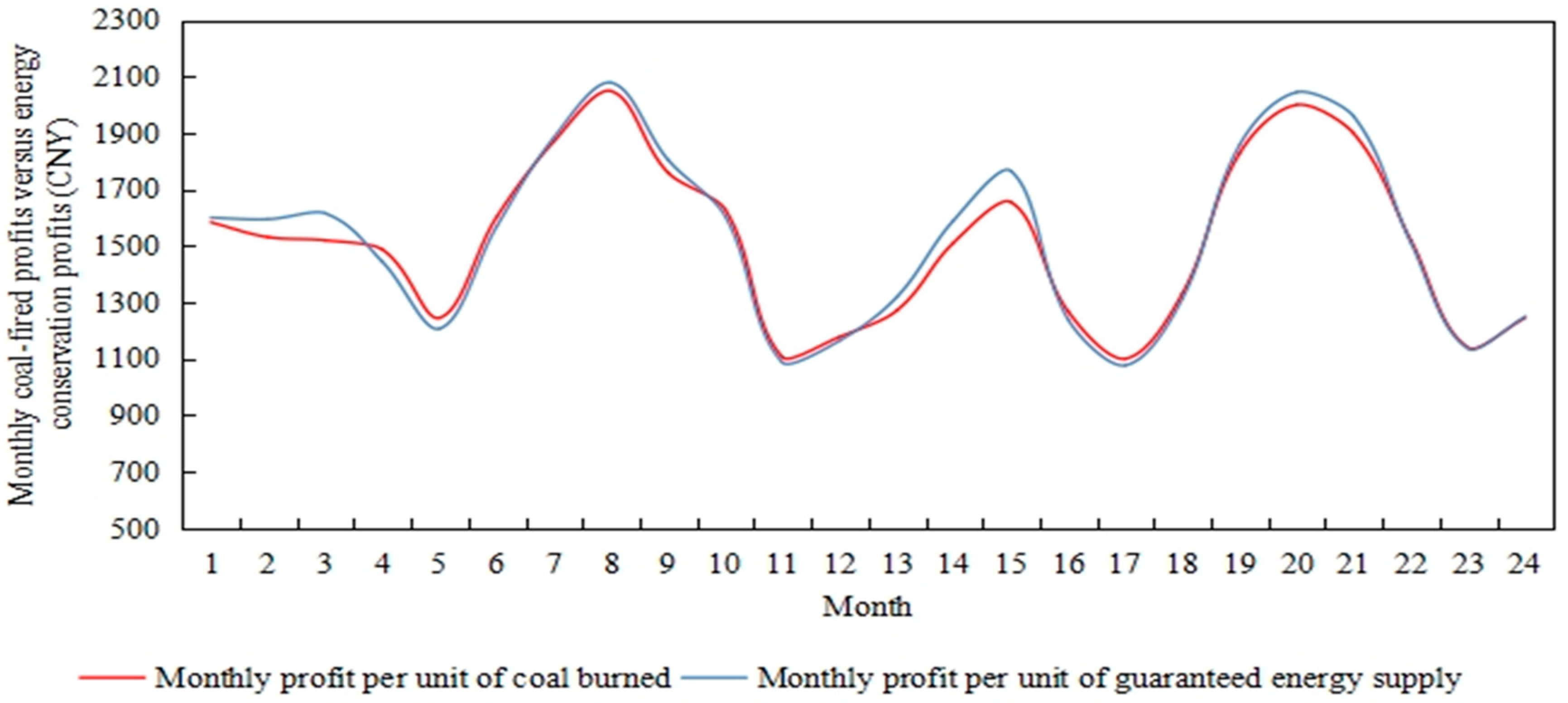

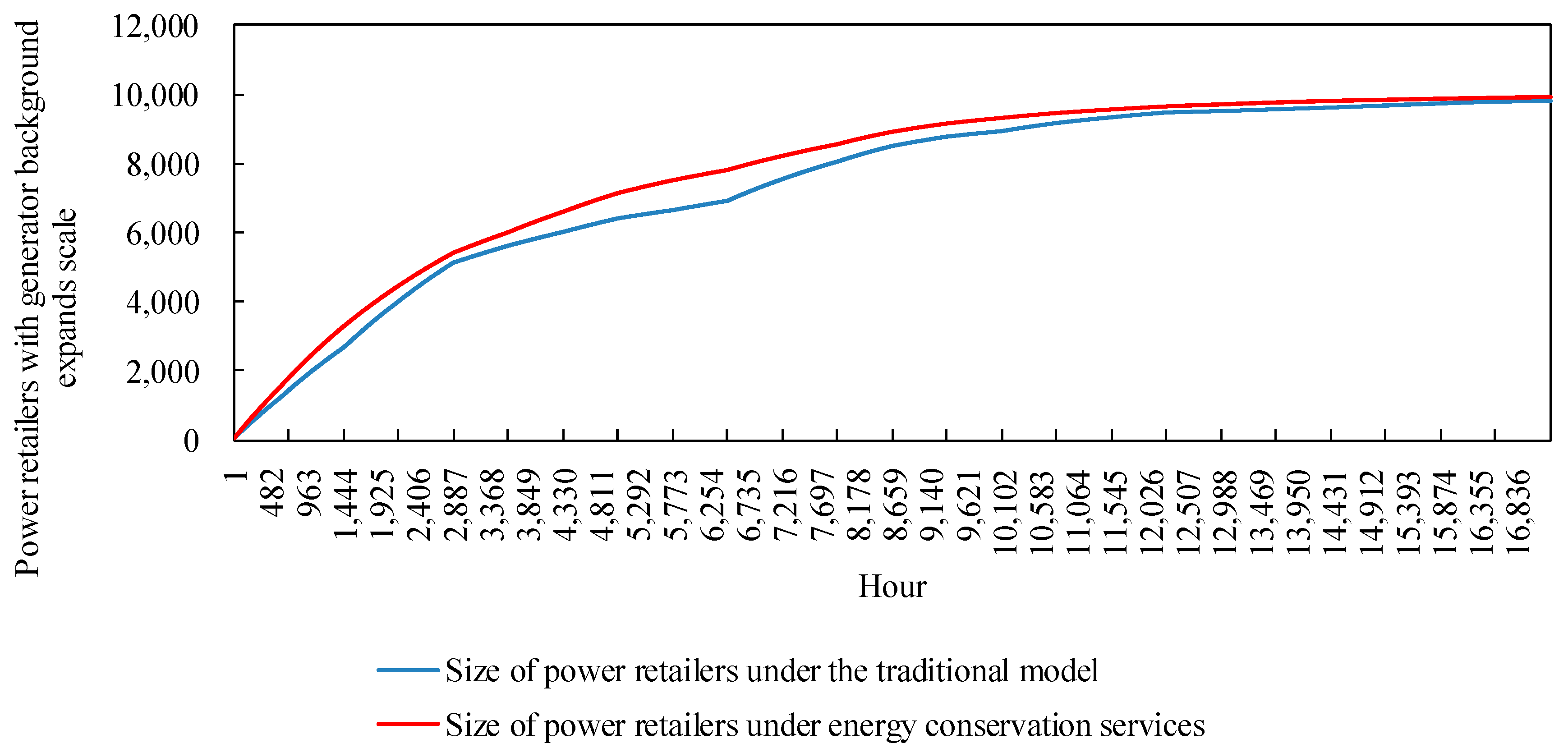
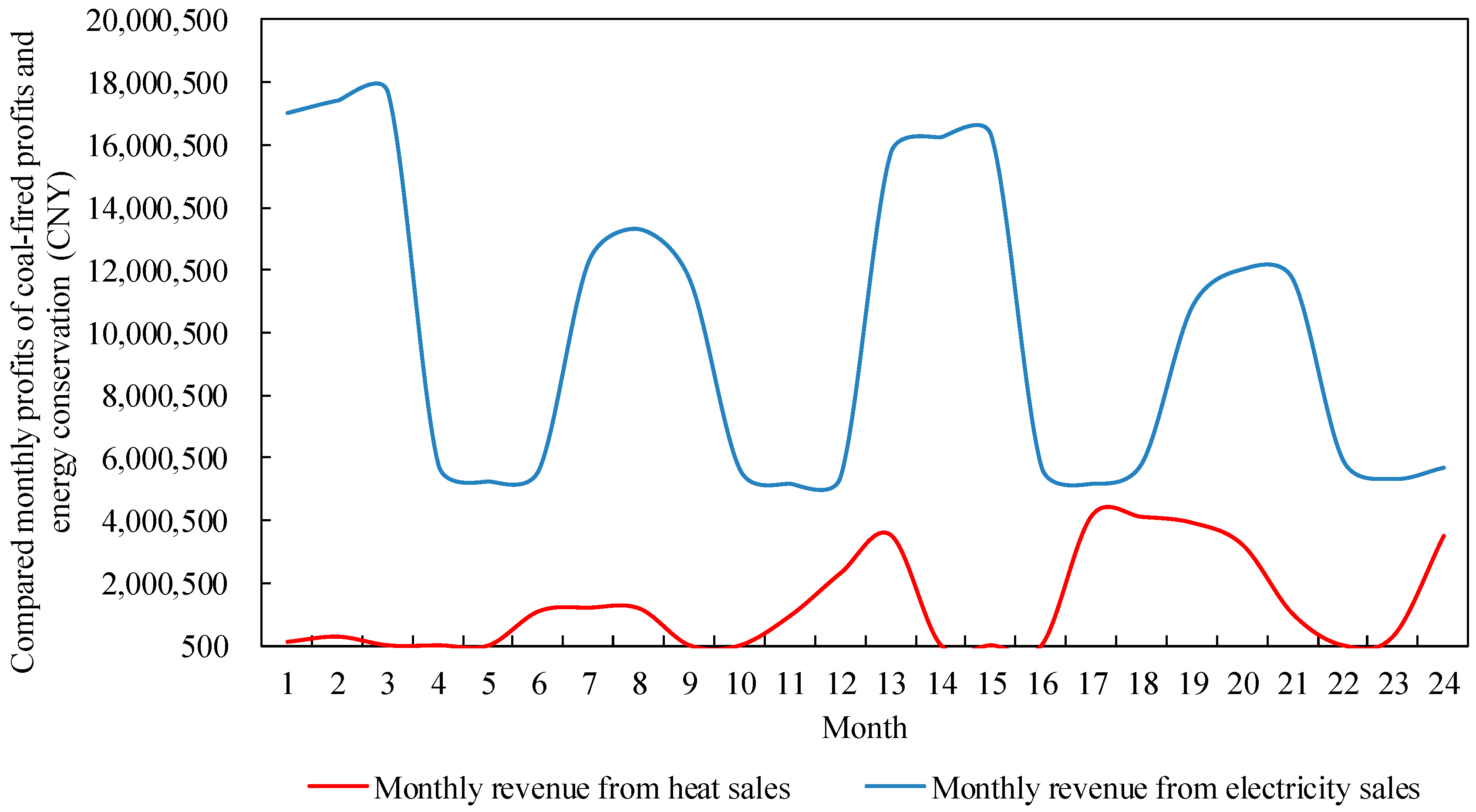
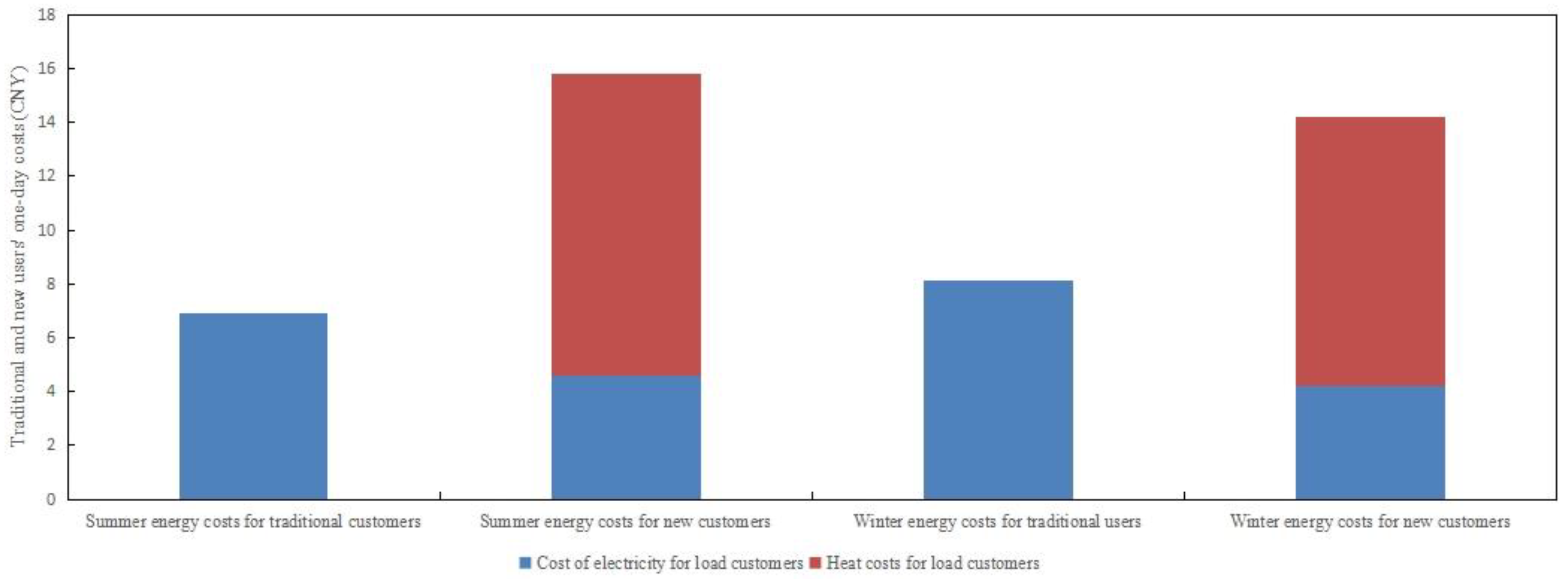

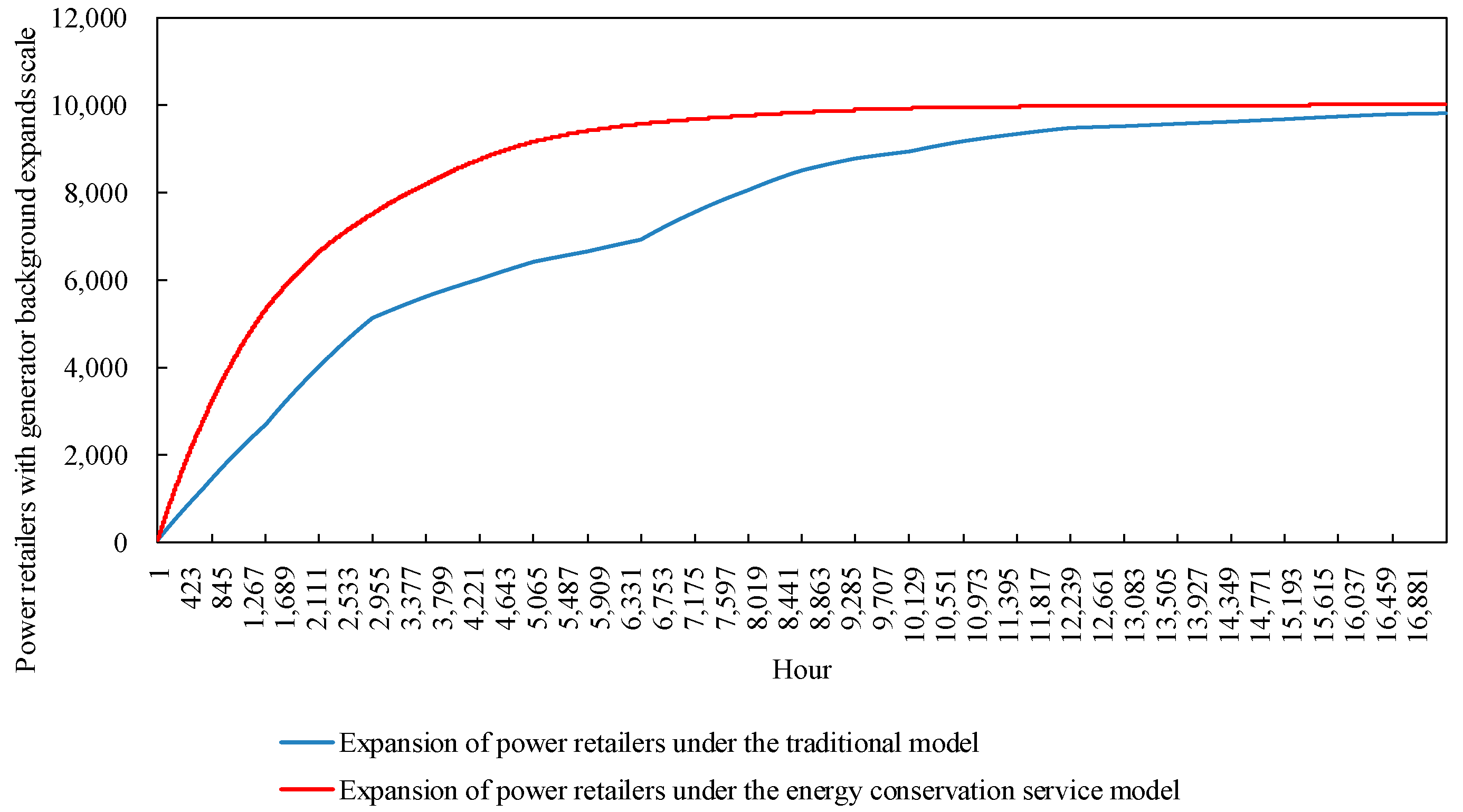
| Parameters | Formula |
|---|---|
| Heat consumption per hour for load users | = New customer base heat consumption × Number of new users + Traditional customer base heat consumption × Number of traditional users |
| Electricity consumption per hour for load users | = New customer base electricity consumption × Number of new users + Traditional customer base electricity consumption × Number of traditional users |
| Actual coal burned by generators | = min {max {The heat required to set electricity by heat, The heat required to set heat by electricity}/Heat production per unit of standard coal, Amount of coal that can be burned by generators} |
| User appeal | = 1 + (Traditional user expenditure costs − New user expenditure costs) /Traditional user expenditure costs) |
| Parameters | Formula |
|---|---|
| Carbon emissions per hour from power retailers | = 3.668 × Actual amount of coal burned per hour by generators × (1 − Rate of heat loss from incomplete combustion) × Oxidation rate of carbon × Carbon content of the base received from burning coal [19] |
| Cost per hour of carbon emissions for power retailers | = Average carbon emissions per hour × Average carbon price per hour |
| Sulphur emissions per hour for power retailers | = 2 × Actual amount of coal burned per hour by generators × Sulphur content of standard coal × Sulphur dioxide conversion × (1 − FGD efficiency) [20] |
| Cost per hour of FGD for the power retailers | = Average sulfur emission per hour × Unit Sewage Charges + Production costs for FGD systems |
| Benefits of FGD systems | = Proceeds from the sale of FGD gypsum + FGD electricity tariff subsidy |
| Parameters | Formula |
|---|---|
| Cost per hour for energy assurance services for power retailers | = Energy conservation service electricity tariff × Energy conservation services electricity supply + Energy conservation service heat tariff × Energy conservation services heat supply + Unit price per hour for energy conservation services |
| Energy conservation services power supply | = abs {min {Power retailers ‘hourly outgoing transmission volume − Hourly electricity demand of load consumers, 0}} |
| Energy conservation services heat supply | = abs {min {Power retailers deliver heat every hour − Heat demand per hour for load users, 0}} |
| Parameters | Data |
|---|---|
| Heat generated per unit of standard coal burned (kJ/kg) | 29,301 |
| Amount of coal required per unit of electricity generated (kg/(kW·h)) | 0.3 |
| Heat required per unit of electricity generated (kJ/(kW·h)) | 8000 |
| Power Generation Commercial Coal Reserve Ratio | 0.001 |
| Proportion of electricity used by generators’ plants | 0.0475 |
| Heat ratio for generators’ plants | 0.01 |
| Percentage of operation and maintenance costs for generators | 0.323 |
| Unit operation and maintenance costs of energy storage plants/(CNY/(kW·h)) | 0.6 |
| Hot water storage tank unit operation and maintenance into/(CNY/kJ) | 0.00002 |
| Transmission heat loss rate | 0.1 |
| Transmission power loss rate | 0.0469 |
| Market size | 10,000 |
| Parameters | Data |
|---|---|
| Sulphur content of standard coal | 0.008 |
| Sulphur dioxide conversion | 0.9 |
| Desulphurization gypsum to sulfur dioxide ratio | 2.69 |
| Purity of desulphurization gypsum | 0.9 |
| Parameters | Data |
|---|---|
| Oxidation rate of carbon | 0.008 |
| Rate of heat loss from incomplete combustion | 0.9 |
| Carbon content of the base received from burning coal | |
| Carbon price floor | 2.69 |
| Carbon price cap | 0.9 |
| Parameters | Data |
|---|---|
| Fluctuations in electricity consumption | 0.01 |
| Fluctuations in heat consumption | 0.02 |
| Average power of user equipment | 0.4097 |
| User willingness factor | 0.091 |
| Total number of users in the region | 50,000 |
| Parameters | Data | |
|---|---|---|
| Unit Price for Energy Conservation Services (CYN/h) | 200 | |
| Energy Conservation Services Heat Tariff (CYN/kJ) | 0.000003 | |
| Energy Conservation Service electricity tariff (CYN/(kW·h)) | 0.25 | 0 < t < 6 or 22 < t ≤ 24 |
| 0.28 | 6 ≤ t ≤ 22 | |
| Traditional Model | Proposed Model |
|---|---|
| Revenue at a lower wholesale price | Revenue is obtained by “fixing electricity by heat” and “fixing heat by electricity” based on multi-energy needs of users |
| Increased cost burden due to upward fluctuations in coal prices | The proportion of energy loss and emergency reserve of power producers is reduced. During the upward period of coal price, electricity and heat energy are purchased from energy supply service providers for users, thereby reducing the cost of coal purchase. |
| The diffusion of commercial packages restrained by higher energy supply prices on the user side | By setting up the energy conservation service, abandoning the heat income in the new package to increase the electricity price and packaging the heat and cold energy as a gift for electricity, greatly enhancing the diffusion efficiency of the new package on the user side |
Publisher’s Note: MDPI stays neutral with regard to jurisdictional claims in published maps and institutional affiliations. |
© 2022 by the authors. Licensee MDPI, Basel, Switzerland. This article is an open access article distributed under the terms and conditions of the Creative Commons Attribution (CC BY) license (https://creativecommons.org/licenses/by/4.0/).
Share and Cite
Dou, X.; Zhou, J.; Ding, Y.; Li, J.; Cao, Y.; Shan, M.; Yuan, H. Retailing Strategies for Power Retailers with a Generator Background Considering Energy Conservation Services under the Internet of Things. Sensors 2022, 22, 6612. https://doi.org/10.3390/s22176612
Dou X, Zhou J, Ding Y, Li J, Cao Y, Shan M, Yuan H. Retailing Strategies for Power Retailers with a Generator Background Considering Energy Conservation Services under the Internet of Things. Sensors. 2022; 22(17):6612. https://doi.org/10.3390/s22176612
Chicago/Turabian StyleDou, Xun, Jiazhe Zhou, Yanbo Ding, Jiacheng Li, Yang Cao, Maohua Shan, and Hao Yuan. 2022. "Retailing Strategies for Power Retailers with a Generator Background Considering Energy Conservation Services under the Internet of Things" Sensors 22, no. 17: 6612. https://doi.org/10.3390/s22176612
APA StyleDou, X., Zhou, J., Ding, Y., Li, J., Cao, Y., Shan, M., & Yuan, H. (2022). Retailing Strategies for Power Retailers with a Generator Background Considering Energy Conservation Services under the Internet of Things. Sensors, 22(17), 6612. https://doi.org/10.3390/s22176612







